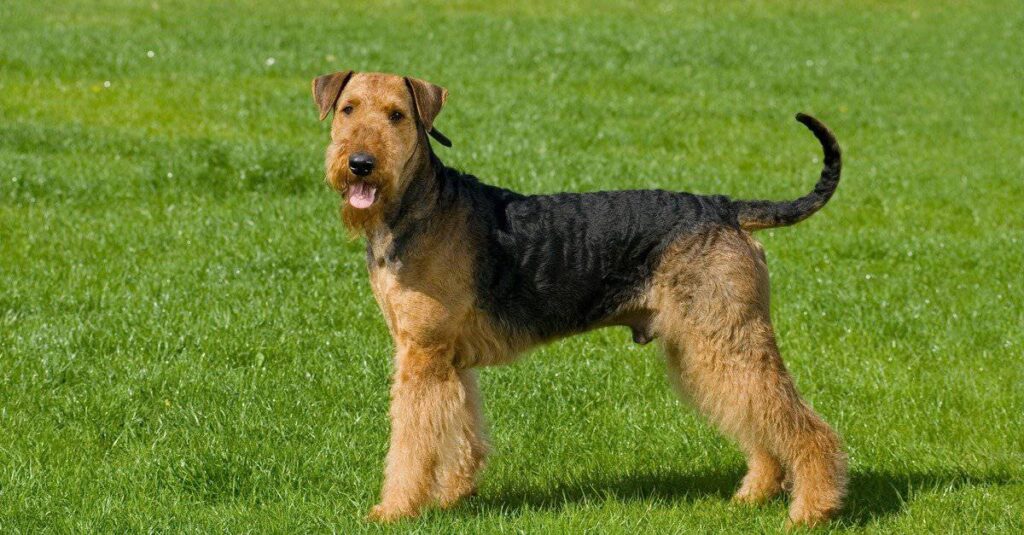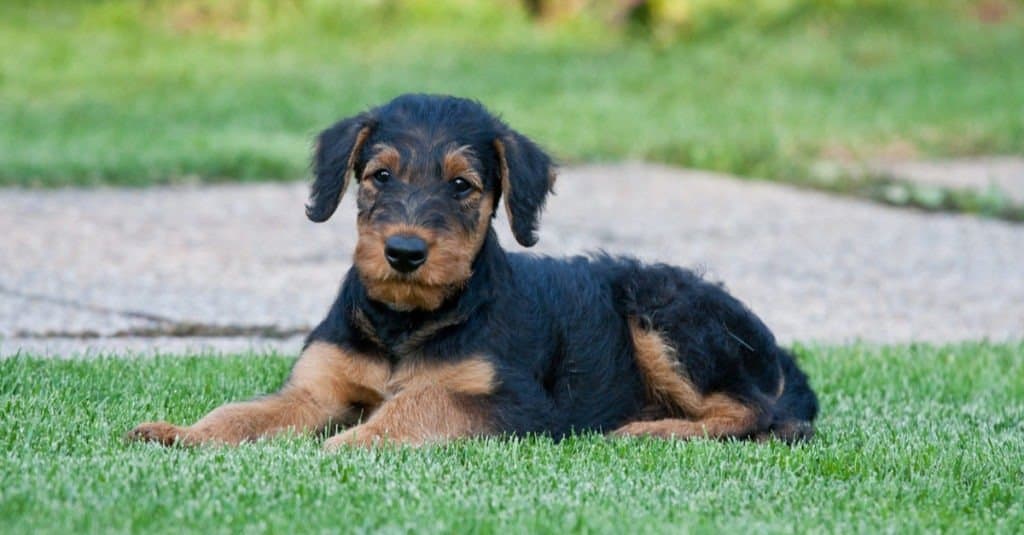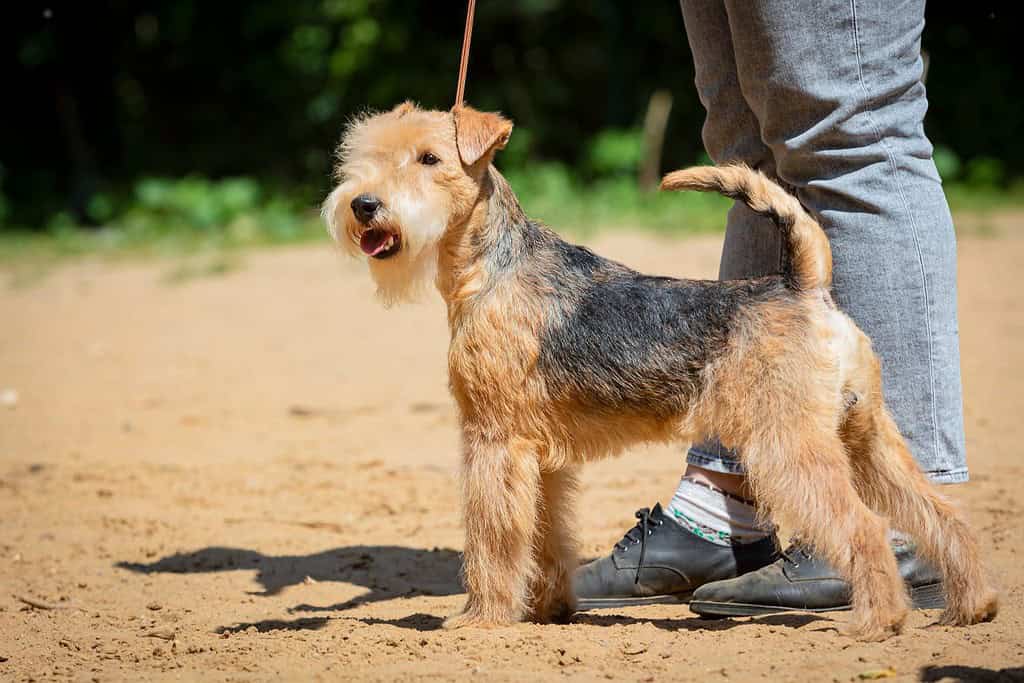Hailing from England’s Yorkshire region, the Airedale terrier is a playful pup and versatile working dog. Known as the “King of Terriers”, this large breed is a distinguished dog with a wealth of talents. Smart, courageous, and loyal, Airedale terriers make excellent companions and protectors. Their impressive credentials are even matched by their distinguished appearance, with a proud posture that commands respect. Let’s dive into the unique characteristics of the Airedale terrier coat, from its bold colors and patterns to its unique texture and feel!
The Airedale Terrier

Airedale terriers are playful and friendly dogs.
©Dora Zett/Shutterstock.com
Originating from a mix of different terriers and the otterhound, the Airedale terrier is the largest terrier out there! People bred these dogs to be generalized workers with many skills, making them excellent for hunting, tracking, guarding, fetching, and even herding. For a long time, Airedale terriers were mainly kept by the working class in Yorkshire, England.
However, in the 1890s, Germany began using Airedale terriers as police and war dogs. Then, in 1910, Col. Edwin Richardson established the British War Dog School, which included several Airedales, including one rather famous dog named “Jack”. Jack was sent to the front during World War I, where he delivered a critical message across an active battlefield. Following the war, Airedale terriers quickly rose in popularity.
Coat Colors and Patterns

Airedale terrier puppies have a ton of energy and can be quite rambunctious.
©Lenkadan/Shutterstock.com
Fully grown Airedale terriers stand 23 inches tall at the shoulders and weigh 50 to 70 pounds. However, when they first come into the world they are tiny bundles of black fur, weighing just 10 to 12 ounces. While they may have some tan markings, these cute pups are almost entirely black from head to toe.
As Airedale puppies grow up, the bits of tan fur steadily expand, gradually replacing much of their black puppy fur. By adulthood, Airedale terriers generally sport two main colors: black and tan or black and grizzled. However, there are a few variations:
- The classic black and tan coat
- Grizzled variations
- Red coats
- White markings
- Other rare Airedale colors
1. The Classic Black and Tan Coat

The black saddle pattern of an Airedale terrier typically shows up on the sides of the body, the upper back and neck, and the top of the tail.
©Grisha Bruev/Shutterstock.com
With black and tan Airedales, the black forms a saddle-like pattern on their backs and sides, contrasting beautifully with their otherwise tan fur.
2. Grizzled Variations

The amount of grizzled hair on an Airedale determines how much of the black saddle can be seen.
©V_oo/Shutterstock.com
Occasionally Airedale terriers may have a grizzled coat. The saddle pattern on their bodies is still black, but these black hairs are interspersed with white and gray hairs, creating a unique salt-and-pepper or “grizzled” coloring. These Airedales look slightly grayish or lighter in color with a faded saddle pattern.
3. Red Coats

Airedale terriers can have red hairs anywhere in their coats, which can sometimes be mistaken for “grizzled” patterns.
©Aleks Silchenko/Shutterstock.com
Some Airedale terriers may also have some red or reddish-brown coloring alongside their black and tan markings, or even mixed into the black sections of their coats.
4. White Markings

A white patch on the chest is not very common in Airedale terriers.
©TinoFotografie/Shutterstock.com
Although most breeders and pedigree shows do not like them, some Airedales have small white patches on their chests. Puppies may even start out with white hairs on their toes or legs, but these usually disappear as they get older.
5. Other Rare Airedale Colors

It is extremely uncommon to see a solid-colored Airedale terrier.
©Doodeez/Shutterstock.com
Although extremely rare, some Airedale terriers may have either a fully black coat or an entirely tan one without any markings at all. In one rather unusual case, two Airedale puppies even had coats with white spots!
Airedale Terrier Coat Length and Feel

The name “Airedale” comes from the breed’s origin near the River Aire.
©Kanyshev Andrey/Shutterstock.com
Airedale terriers have medium-to-short hair and a unique “broken coat”. This means that instead of soft, fluffy fur, their coat is tough and wiry, with a stiff outer layer that protects the softer undercoat. However, the wiry texture typically lies flat against the body and avoids an otherwise scraggly appearance. When petting an Airedale terrier, you’ll mostly feel this wiry, outer coat, which can feel a bit like coarse, beard hair. Its rough texture helps to protect the dog’s softer undercoat, which acts like insulation to keep the dog warm. Pedigree and show dogs typically have slightly crinkled or wavy hair, along with a distinguished-looking short beard.
Grooming an Airedale Terrier

When socialized early, Airedale terriers are excellent family dogs.
©aharad/Shutterstock.com
While breeders may promote Airedales as hypoallergenic (there’s no scientific proof for this), their low shedding can make them a good fit for allergy sufferers. Airedale terriers should be brushed once a week to remove dead hair and prevent mats, which also helps to reduce shedding and allergens in your home. They need regular baths as well, but brushing is the main priority with these dogs. In addition, professional grooming is recommended at least four times a year.
Grooming an Airedale terrier involves shaping their coat through clipping and stripping, which removes dead fur and promotes healthy new growth. Some owners prefer a short, sharp haircut for a clean and easy-to-manage look, while others may opt for a puppy cut or an adorably shaggy full coat. Airedales also need regular nail trims and ear cleanings for optimal health and happiness.
Depending on your dog’s training and temperament, Airedale grooming can be a bit of a challenge. The dog’s playful spirit makes it hard for them to hold still for long grooming sessions, and their independent streak can turn into stubbornness when they decide they’ve had enough. Although you can groom your dog at home, opting for a professional groomer can help alleviate this stress.
The photo featured at the top of this post is © Grisha Bruev/Shutterstock.com
Ready to discover the top 10 cutest dog breeds in the entire world?
How about the fastest dogs, the largest dogs and those that are -- quite frankly -- just the kindest dogs on the planet? Each day, AZ Animals sends out lists just like this to our thousands of email subscribers. And the best part? It's FREE. Join today by entering your email below.
Thank you for reading! Have some feedback for us? Contact the AZ Animals editorial team.







